高中英语新教材UNIT4教学设计
- 格式:docx
- 大小:115.82 KB
- 文档页数:23
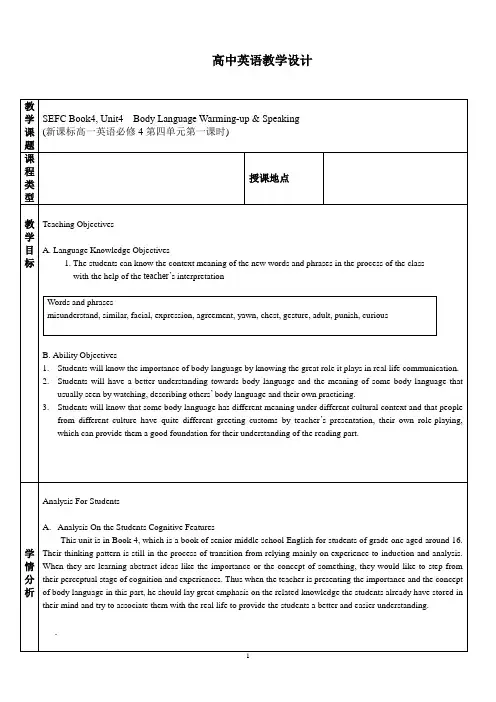
高中英语教学设计教学重难点Teaching FocusMake the students understand that body language has cultural diversity and there is no division of good or bad for the diversity.ChallengeMake sure that the students will have the awareness to use and try to understand others’ body language when they communicate with others in the future.教学准备A. A projectorB. computer for multimedia teaching教学方法Teaching methodsA. Asking-and-answering between the teacher and the studentsB.. Interaction among individuals, pair-work and group-workC. Task-based teachingD. Teacher’s demonstration and interpretationE. Role-playingF. Students’ discovery教学过程设计活动内容Step 2介绍身势语的重要性A.Telling Students the Story of Tai Lihua and Making Them Know theImportance of Body Language in Her Life ( 3 min )1.Present the pictures of Thousands of Hands Kwan-yin , and ask the students whether they know thegirl who dances in the front.2. Tell the students tell life story of Tai Lihua and ask them the question “What are the key factors forher success in her life?”The life story of Tai LihuaHer name is Tai Lihua(邰丽华). She is called a Fairy of Peach blossom(桃花仙子) by people. You knowshe is a deaf girl, but she is a wise, diligent, charming and energetic girl. She studied very hard and got two degrees of bachelors in university. She was famous as an artist for her wonderful performance. She is deafand dumb. But how did she get that great achievement and became a successful person? She loves life very much. We should learn from her spirit. Besides her hard working, body language plays a very importantpart in her life. We are all healthy people, sometimes we can use body language to express ourselves. Sowe should pay more attention to learning body languages.B.Showing the Students the Science Report of the Importance Body Language,Making Them Know That Body Language Is As Important For Us As ForDisabled Person Like Tai Lihua. ( 1 min )Some psychologist believe that we communicate 65% of our ideas and feelings without words! The shape of our bodies and faces, the movements and gestures we make, the clothes we wear, how near we stand to each other and whether we touch each other…all these communicate. we must study all these types of information if we want to truly understand what other people are saying.Step 3介绍不同类型的身势语() ( step 3 will use around 5 min )A. Showing the Students The Four Types of Body LanguageGestureFacial expressionEye contactPostureB. Guessing The Meaning of GesturesThe teacher show the students a series of pictures of a man using different gestures, and the students are supposed to say their meaning.C.Acting Out By GesturesThe teacher show the students some English words and ask them to act them out together by using gestures.Victory!Ok !Be quiet!You!D. Chasing the Right WordThe teacher will show the students a series of pictures describing different facial expressions and askthe students to choose the right word for each.E. Matching the Right Interpretation Of the EyesThe teacher will present students several pictures of eyes and ask the students to match the right interpretation.Threatening No. sixThank you ! Congratulations!Facial expressionanger fear joy sorrow contempt轻视surprise disgust 厌恶What do you see in the eyes below?That’s a problem. I need to thinkfor while.a whileIt’s you! Let’s have a duel!That’s horrible! I’m terrified!The next minute,you’re a dead body!I’m in great sorrownes s…I won’t give up! We’ll soon winback!F. Guessing The Meaning of Postures in Real ContextI’m listening carefully!What do we know from their posture?Nice to meet you!This woman is listening to your ideas…You meet this man for the first time…Give me a little time!I’m still thinking!You are asking this womanTo finish her work as soon as possible…You are asking this woman ”Have you got any good idea?” …I give up!OK!You are asking help from this woman…You are saying “Will you give up!”…G. Matching the Right Meaning of the Given Posturesnervous Bite your nails and fondle hair agreement Nod the head up and downBe not interested Look away or yawn.Do not believe Roll your eyes and turn your head away. angry Frown and turn your back to sb disagreement Shake the headStep 4给身势语下定义A.Finishing the First Question of Warming-up Part ( 3 min )The teacher will ask the students to discuss the question with your partner and try to find what the people in the pictures are communicating.B.Giving Definition To Body Language ( 2 min )The teacher will guide the students to give a general definition to body language.Body languageis a form of non-verbal communication.uses movements or positions of our body to show other people what we are thinking or feeling.mainly includes gesture, facial expression, eye contact, posture four forms.Step 5练习运用身势语A.Acting Out the Following words ( 4 min )This exercise is based on the second question of warming-up part. Two students will be chose to the frontof the class, and each of them will choose five words to act. After their action, other students will try to guess which word they have acted.•Hello!•Goodbye!•Go away!•Expensive!•I’m surprised!•I’m tired•I’m confused!•Good luck•I’m delighted!•I’m upset!•I’m sad!•I forgot!•You are great!•I’m curious!•I ate too much!•Come here!B.Acting Out the Dialogue on Page 67 ( 10 min )The student will work in groups of two to finish the speaking task of this unit on page 67. They are required to use appropriate body language as they are making dialogues. After their pairwork, volunteers will make their dialogue before the whole class.Step 6介绍身势语的文化多样性A.Showing the Cultural Difference in Body Language With Examples ( 2 min )America OKJapan moneyFrance zeroBrazilGermanyrudeB . Presenting the Students the Major Greeting Customs in the World ( 2 min )Person and country Suitable greeting A man from ColumbiaTo a man: same as for a womanTo a woman: touches her shoulder and kissesher on the cheekA woman from BritainTo a man: not to close, shake hands To a woman: shake hands, will get closeA man from JapanTo a man: bowsTo a woman: bowsA man from CanadaTo a man: shake handsTo a woman: shake hands or kisses on both cheeks if knownA woman from FranceTo a man: shake hands, kisses twice on the cheekTo a woman: same to someone she knowsA man from the Middle East or some Muslim countriesTo a man:comes close, shakes handsTo a woman:nodsC. Discussion On the Question That If There is a Division of Good or Bad of the Different Meaning of The Same Body Language Under Different Culture.The students will have 3 minutes for discussion and after that some of them will represent their group to share their idea with the whole class.Step Role Play ( 8 min )USA Nigeria rude Germany Japanone“great”or “good job”。
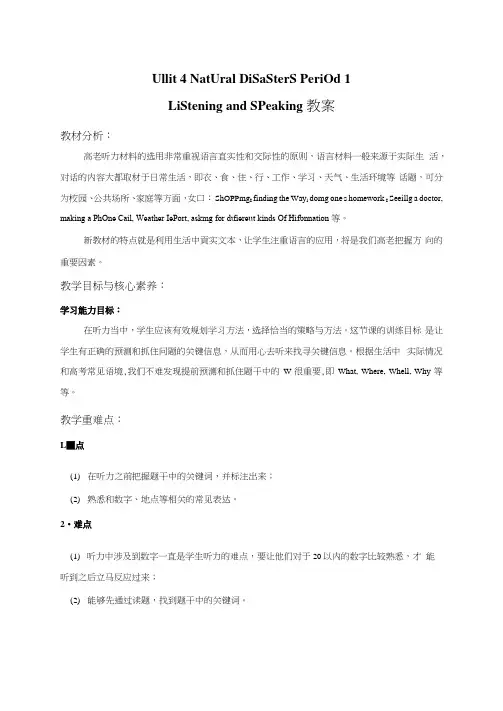
Ullit 4 NatUral DiSaSterS PeriOd 1LiStening and SPeaking 教案教材分析:高老听力材料的选用非常重视语言直实性和交际性的原则,语言材料一般来源于实际生活,对话的内容大都取材于日常生活,即衣、食、住、行、工作、学习、天气、生活环境等话题,可分为校园、公共场所、家庭等方面,女口:ShOPPmg I finding the Way l domg one,s homework I Seeillg a doctor, making a PhOne Cail, Weather IePort, askmg for dιfiereιιt kinds Of Hifbnnation 等。
新教材的特点就是利用生活中貢实文本,让学生注重语言的应用,将是我们高老把握方向的重要因素。
教学目标与核心素养:学习能力目标:在听力当中,学生应该有效规划学习方法,选择恰当的策略与方法。
这节课的训练目标是让学生有正确的预测和抓住问题的关键信息,从而用心去听来找寻关键信息。
根据生活中实际情况和高考常见语境,我们不难发现提前预测和抓住题干中的W很重要,即What, Where, Whell, Why 等等。
教学重难点:L■点(1)在听力之前把握题干中的关键词,并标注出来;(2)熟悉和数字、地点等相关的常见表达。
2•难点(1)听力中涉及到数字一直是学生听力的难点,要让他们对于20以内的数字比较熟悉,才能听到之后立马反应过来;(2)能够先通过读题,找到题干中的关键词。
教学过程:Unit 4 NatUrai DiSaSterS PeriOd 2Reading and Thinking 教案教学目标与核心素养:1.TeaCh SnIdelItS to find OUt the ParagraPh topic Sentelices, UnderStaild the basic InfbnllatIoII Of die TangShall earthquake tlιrouglι SkHliining, SearCIlIng aιιd Other Ieadmg SkiIIs.2.Enable SnldelltS to SOrt OUt the details Of the paragraph, to UnderStand the Strange things before die TangShan earthquake, the tremendous destructive force CaUSed by the eartlιquake, and the IaPld and SeIfleSS rescue and reconstruction after the disaster.3.DiSClISS the tliuiking brought by eartlιquake and SUblillIate the theme SignIfiCanee.教学重难点:1.DeVelOP students' IeadIng ability SUCh as Skmiming, SCanning and SllIninarIZing.2.Let StlIdentS talk about the PreCUrSOr before the earthquake, the damage CaUSed by theearthquake, the IeSCUe after die earthquake and die reconstnιctιon after die earthq uake.教学过程:SteP 1 ACtivity 1ACtiVating background informationT: TOday We are gomg to Iearn a PaSSage With the title -The Night the EartIl Didn't Sleep,∖ SO Why didn't the earth SleeP on that night? What happened to the earth? ACnlany there is a movie directed by Feng XlaOgang focuses On the SaIIle earthquake. Now, Γd IIke to ShOW you a SIlOrt CllP Of die movie.1.TaIk about the earthquakeQl: What do you Ieanl from the video?2.Talk about TangShall earthquake.Ql: What do you know about TangShan earthquake?Q2: What do you Want to know about it?SteP 2 AXtiVity 2Reading to get SOme basic information about earthquake1.Read quickly to find the answers to the students' OWn questions.2.Read for the topic SentelICeS and ∖λr ork OUt the OrgallIZatIOn Of die text.Ql: What,s tlιe topic SentenCe m each paragraph?Q2: In What Order does the author describe die earthquake?SteP 3 ACtiVity 3Reading for detailed information1.Read to get detailed information about ParagraPh 1.Ql: What Were tlιe Strange tilings?Q2: What WaS people's IeaCtIOn to tlιese Strange tilings?Q3. Why didn't PeOPle Pay attention to these Strange thmgs/the SignS before the earthquake? T: PeOPle had Iittle knowledge Of earthquake at tlιat tune.Q4: When does this ParagraPh mainly talk about?T: AbnOnilal SigllS before the eartlιquake.2.Read to get detailed InfbrmatiOn about ParagraPh 2.Ql: HOW StrOng WaS die earthquake?Q2: HOW did the PeOPle feel Whell die earthquake happened?Q3: What does this ParagraPh mamly talk about?3.Read to get detailed information about Para. 3.Ql: What Were destroyed?Q2: HOW does die ∖λτιter describe 飞VerythIng iιι the city"?Q3: HOW did the PeOPle feel?Q4: What does this ParagraPh mamly talk about?4.Read to get detailed information about ParagraPh 4.Ql: WhO brought hope back? And Wllat did tlιey do?Q2: HOW did the PeOPle feel after a IOt Of PeOPle Came to rescue?Q3: HOW WaS the City after a IOt Of PeOPle Came to rescue?5.Read to get detailed InfbrmatiOn about ParagraPh 5.Ql: What ShOWS the revival OfTangShaιι?Q2: HOW Call TallgShaIl WViVe itself aιιd get UP On its feet agam?Q3: In tmιes Of disasters, how Can We go tlιrouglι it?T: Iii times Of disasters, We ShOUld unify; ShOW the WiSdom and Stay positive.SteP 4 AXtiVity 4HighIighting the theme and reflecting1.Make a SuinnIary Of die text.2.FUrther IInderStalld the titleQ: After Ollr Ieanimg, Why do you tlιιnk the earth didn't SleeP On tlιat Ilight?T: An earthquake happened. The PeOPle In the earthquake SUfiered a lot. and die PeOPle OUtSide TangShall Λλ-ere ConCemed about the PeOPle there a lot.3.RefleCt tlιroιιglι discussion on Wllat Can be Ieamt after reading.T: DISaSterS are POWerfiIL UnPreParedlleSS Call be deadly. Life is weak, but if PeOPle V t r QTk togetherto help each otlιer5 disasters Can be defeated.TIlere is no IOVe &om disaster, but We have IoVe In the human heart.SteP 5 ASSignmentHOW does the WrIter COlIVey tlιat the earthquake WaS deadly, and tlιat PeOPle Were helpless durmg tlιe earthquake? Try to find SOme attractive and impressive expressions and note them down.UIlit 4 NatUral DiSaSterS PeriOd 3DiSCOVering USefUl StrUCtUreS 教案教材分析:ThiS teaching PerIOd mainly deals With the granmiar: die restrictive relative clauses.ThiS PeriOd carries COnSIderable SignIfiCanCe to the CUlthβatιon Of students' Writing COmPetellCe and IayS a SOlId foundation for the basic appreciation Of Iallgllage beauty. The teacher is expected to enable StUdentS to master tlιis PerIOd thoroughly aιιd COaSOIIdate the knowledge by doing SOme exercise Of good quality.教学目标与核心素养:1.Get SnldentS to ha∖∙e a good IUIderStandlllg Of the basic USageS Of the restrictive IelatiVe clauses.2.Enable SnIdentS to USe the TeSniCtIVe relat∏∙e CIaUSeS flexibly.3.DeVelOP students' SPeaklllg and COOPeratmg abilities.4.Strellgtllell students' great mterest iιι grammar Ieainmg.【学堇难点:HOW to enable SnldentS to have a good ImderStanding Of the restrictive relative clauses, espeCiaIly the IISeS Of the IeIath*e WOrdS SUCh as which, that, who, whom.教学过程:StePl语法知识呈现定语从句(一)——关系代词的用法在复合句中,修饰名词或代词的从句叫定语从句。
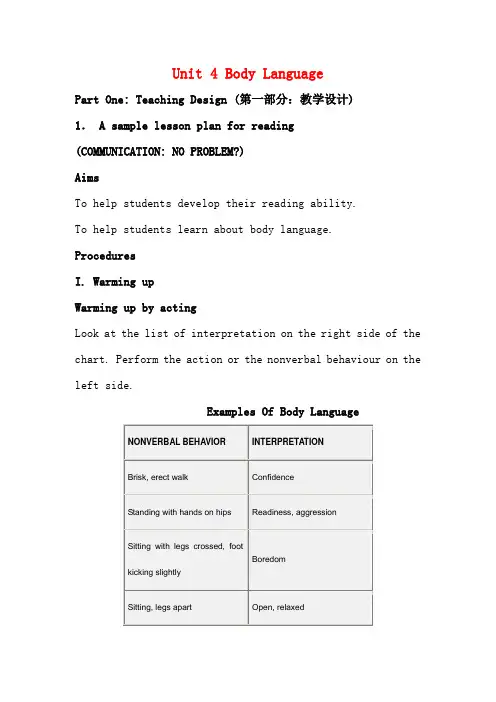
Unit 4 Body LanguagePart One: Teaching Design (第一部分:教学设计)1. A sample lesson plan for reading (COMMUNICATION: NO PROBLEM?)AimsTo help students develop their reading ability.To help students learn about body language.ProceduresI. Warming upWarming up by actingLook at the list of interpretation on the right side of the chart. Perform the action or the nonverbal behaviour on the left side.Examples Of Body LanguageWarming up by defining—What is body language?II. Pre-reading1. Looking and sayingLook at the man in the picture below. What does he say to you by his body language?Basically, how the ...... do I know? Or, I don’t know nothin! The shoulders are hunched and the hands are open signifyinga big question mark.2. Talking and sharingBody language is the quiet, secret and most powerful language of all!According to experts, our non-verbal language communicates about 50% of what we really mean (voice tonality contributes 38%) while words themselves contribute a mere 7%.Our bodies send out messages constantly and often we don't recognize that we're communicating a lot more than werealize.Our understanding and use of non-verbal cues in facial expression are familiar to us nearly from birthIII. Reading1. Reading aloud to the recordingNow please listen and read aloud to the recording of the text COMMUNICATION: NO PROBLEM?. Pay attention to the pronunciation of each word and the pauses within each sentence. I will play the tape twice and you shall read aloud twice, too.2. Reading and underliningNext you are to read and underline all the useful expressions or collocations in the passage. Copy them to your notebook after class as homework.3. Reading to identify the topic sentence of eachparagraphNext you are to skim the text to identify the topic sentence of each paragraph.4. Reading and transferring informationRead the text again to complete the table. Where is he/ she from? What does he/ she do when he/ she meet someone at the airport for the first time?5. Reading and understanding difficult sentencesAs you have read the text times, you can surely tell which sentences are difficult to understand. Now put your questions concerning the difficult points to me the teacher.6. Reading and translatingNow it’s time to translate the text into Chinese, sentence by sentence. Who will be the first to do it?IV. Closing downClosing down by doing exercisesTo end the lesson you are to do the comprehending exercises No. 1 and 2 on page 26 and 27.Closing down by checkingCheck some of the following basic non-verbal cues and you'll recognize that you already speak and translate much of the language.“I’m surprised!”“I’m shocked!”“I’m sad!”2.A sample lesson plan for Learning about Language(The ~ing form as the Attribute & Adverbial)AimsTo help students learn about The ~ing form as the Attribute & Adverbial.To help students discover and learn to use some useful words and expressions.To help students discover and learn to use some useful structures.ProceduresI. Warming upWarming up by discovering useful words and expressions Turn to page 27 and do exercises No. 1, 2 ,3 and 4 first. Checkyour answers against your classmates’.II. Learning about grammar1. Reading and thinkingTurn to page 25 and read with me the text of COMMUNICATION: NO PROBLEM? As you read along, pay attention to the uses of The ~ing form as the Attribute & Adverbial.(They are visitors coming from several countries. 作定语;Four people enter looking around in a curious way. 作状语;This is an exciting experience for you. 作定语; You stand watching and listening. 作状语;……)2. Doing exercises No. 1 and 2 on page 29Turn to page 29. Do exercises No. 1 and 2。
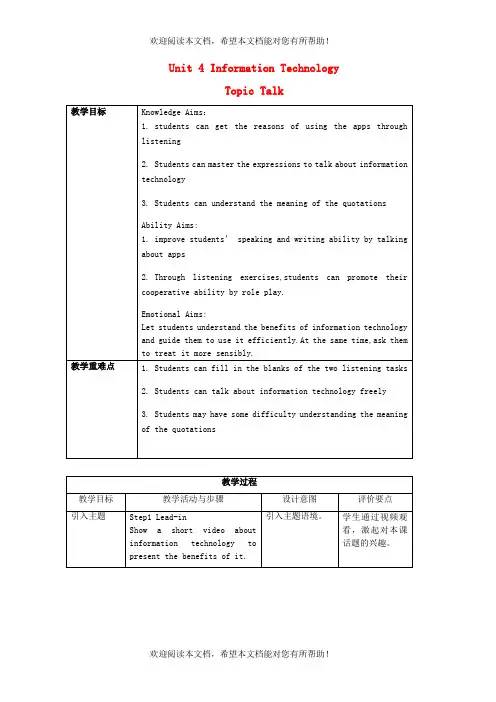
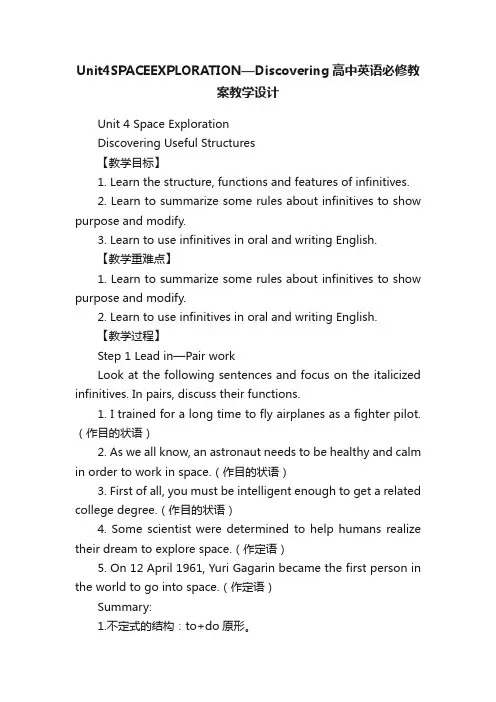
Unit4SPACEEXPLORATION—Discovering高中英语必修教案教学设计Unit 4 Space ExplorationDiscovering Useful Structures【教学目标】1. Learn the structure, functions and features of infinitives.2. Learn to summarize some rules about infinitives to show purpose and modify.3. Learn to use infinitives in oral and writing English.【教学重难点】1. Learn to summarize some rules about infinitives to show purpose and modify.2. Learn to use infinitives in oral and writing English.【教学过程】Step 1 Lead in—Pair workLook at the following sentences and focus on the italicized infinitives. In pairs, discuss their functions.1. I trained for a long time to fly airplanes as a fighter pilot.(作目的状语)2. As we all know, an astronaut needs to be healthy and calm in order to work in space.(作目的状语)3. First of all, you must be intelligent enough to get a related college degree.(作目的状语)4. Some scientist were determined to help humans realize their dream to explore space.(作定语)5. On 12 April 1961, Yuri Gagarin became the first person in the world to go into space.(作定语)Summary:1.不定式的结构:to+do原形。
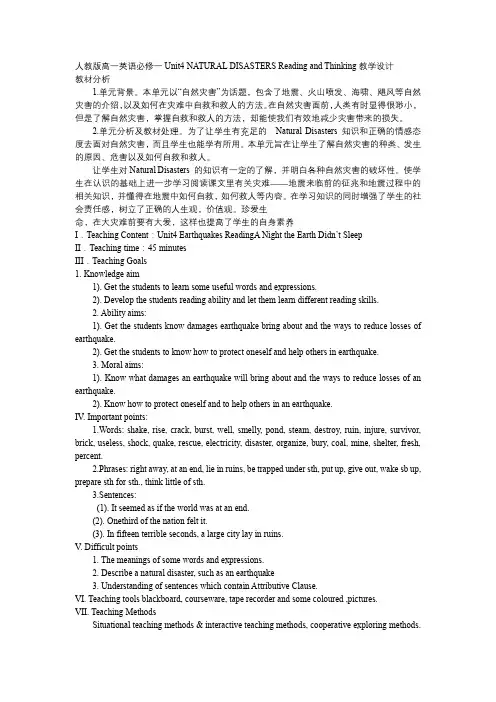
人教版高一英语必修一Unit4 NA TURAL DISASTERS Reading and Thinking教学设计教材分析1.单元背景。
本单元以“自然灾害”为话题,包含了地震、火山喷发、海啸、飓风等自然灾害的介绍,以及如何在灾难中自救和救人的方法。
在自然灾害面前,人类有时显得很渺小,但是了解自然灾害,掌握自救和救人的方法,却能使我们有效地减少灾害带来的损失。
2.单元分析及教材处理。
为了让学生有充足的Natural Disasters 知识和正确的情感态度去面对自然灾害,而且学生也能学有所用。
本单元旨在让学生了解自然灾害的种类、发生的原因、危害以及如何自救和救人。
让学生对Natural Disasters 的知识有一定的了解,并明白各种自然灾害的破坏性。
使学生在认识的基础上进一步学习阅读课文里有关灾难——地震来临前的征兆和地震过程中的相关知识,并懂得在地震中如何自救,如何救人等内容。
在学习知识的同时增强了学生的社会责任感,树立了正确的人生观,价值观。
珍爱生命,在大灾难前要有大爱,这样也提高了学生的自身素养I.Teaching Content:Unit4 Earthquakes ReadingA Night the Earth Didn’t Sleep II.Teaching time:45 minutesIII.Teaching Goals1. Knowledge aim1). Get the students to learn some useful words and expressions.2). Develop the students reading ability and let them learn different reading skills.2. Ability aims:1). Get the students know damages earthquake bring about and the ways to reduce losses of earthquake.2). Get the students to know how to protect oneself and help others in earthquake.3. Moral aims:1). Know what damages an earthquake will bring about and the ways to reduce losses of an earthquake.2). Know how to protect oneself and to help others in an earthquake.IV. Important points:1.Words: shake, rise, crack, burst, well, smelly, pond, steam, destroy, ruin, injure, survivor, brick, useless, shock, quake, rescue, electricity, disaster, organize, bury, coal, mine, shelter, fresh, percent.2.Phrases: right away, at an end, lie in ruins, be trapped under sth, put up, give out, wake sb up, prepare sth for sth., think little of sth.3.Sentences:(1). It seemed as if the world was at an end.(2). Onethird of the nation felt it.(3). In fifteen terrible seconds, a large city lay in ruins.V. Difficult points1. The meanings of some words and expressions.2. Describe a natural disaster, such as an earthquake3. Understanding of sentences which contain Attributive Clause.VI. Teaching tools blackboard, courseware, tape recorder and some coloured ,pictures.VII. Teaching MethodsSituational teaching methods & interactive teaching methods, cooperative exploring methods.VIII. Teaching Procedures1.Greetings2. LeadinTeacher shows some pictures about the earthquake. Students look at the pictures and think of some new words relating to the natural disasters.3.Reading1). Fast readingTeacher shows the title and the photo on page fifty. Let students guess what the text is about. Student will be given five minutes to get the main idea and pay attention to the beginning and any sentences in each paragraph and find out the topic sentence and then match the main idea with each paragraph.Para.1: A.The rescue work.Para.2: B.The revival of the city.Para.3: C.Warning signs before the earthquake.Para.4: D.The happening of the big earthquake.Para.5: E.The immediate effects of the earthquake2). CarefulreadingStudents will be given five minutes to read part one carefully and do the following exercises: What were some of the strange things happening before the earthquake and how did people in react to the signs.How did people in Tangshan react to the signs?A.Ignorant. B.Alert. C.Sensitive. D. Casual3. What rhetorical device(修辞手法) does the author use in the sentence “the water in the village wells rose and fell, rose and fell”?A.Metaphor(比喻).B.Repetition(重复).C.Parallelism(排比).D.Personification(拟人).参考答案A AFunction: To make the description more vivid and involve the readers in the atmosphere.Students read part 2 carefully and do the following exercise and read paragraph 3 to carefully to do the following exercise the teacher will choose some students to show your answers for others1. How can we protect ourselves in an earthquake at school?2.What can you do after an earthquake?(Creative thinking)PostreadingGroupwork(1) Don’t be nervous and keep calm.(2) Don’t try to run out of the classroom.(3) Sit down under your desk.(4) Protect your head by putting your bag on your head.(5) Don’t use lift.(6)If possible,run to the schoolyard.IX. Group workStudents will be given five minutes to have a group of work to have a discussion about how can we protect ourselves in an earthquake at school and what can you do after an earthquake? Whatdo you think helped in the revival of city?What lesson can we learn from these events? Some students will be invited to share their answers for the other students.The spirit of bating disaster relief抗震救灾精神Whether in Tangshan earthquake or in Wenchuan earthquake, the most important thing is the spirit of Chinese people. Every time a disaster happens, we fight against it together and we never lose hope. That is the spirit of bating disaster reliefRecently, in the battle against COVID19, China did the best in controlling the virus. That is the result of the spirit of bating COVID19X. SummarySome students will be invited to have a summary about what did we learn today.XI. Homework1.Write a passage about your feelings after today’s passage learning.2.Finish activity 5.XII. Blackboard writingXIII. Teaching reflection课后反思依据教学目标,对学生的学习过程进行评价,旨在反思教学效果,不断改进自己的教学方法与策略。
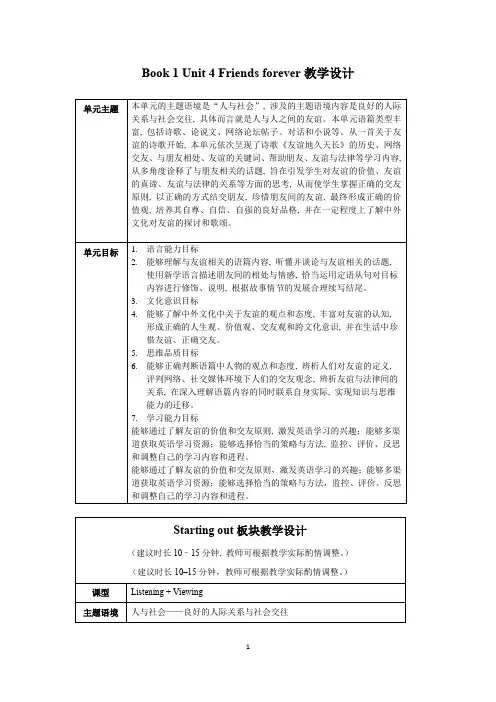
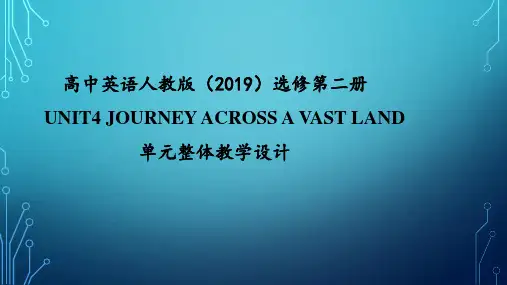
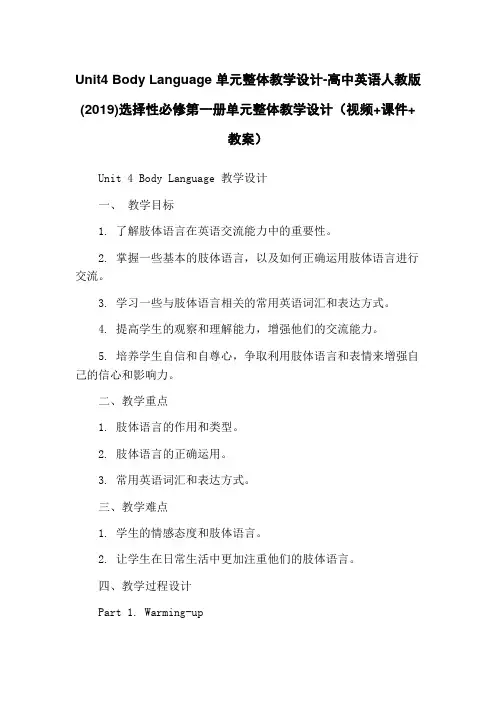
Unit4 Body Language 单元整体教学设计-高中英语人教版(2019)选择性必修第一册单元整体教学设计(视频+课件+教案)Unit 4 Body Language 教学设计一、教学目标1. 了解肢体语言在英语交流能力中的重要性。
2. 掌握一些基本的肢体语言,以及如何正确运用肢体语言进行交流。
3. 学习一些与肢体语言相关的常用英语词汇和表达方式。
4. 提高学生的观察和理解能力,增强他们的交流能力。
5. 培养学生自信和自尊心,争取利用肢体语言和表情来增强自己的信心和影响力。
二、教学重点1. 肢体语言的作用和类型。
2. 肢体语言的正确运用。
3. 常用英语词汇和表达方式。
三、教学难点1. 学生的情感态度和肢体语言。
2. 让学生在日常生活中更加注重他们的肢体语言。
四、教学过程设计Part 1. Warming-upStep 1. Lead-in(1) Name some popular body language movements and invite students to perform.(2) Explain the importance of body language in communication and how a person's movements and expressions reveal his attitude and feelings.Step 2. Discussion(1) Divide students into small groups and discuss how they feel when communicating without body language.(2) Allow groups to share their thoughts and discuss the importance of body language.Part 2. PresentationStep 1. Introduction(1) Use PowerPoint to display and explain some common body language movements.(2) Explain the differences between positive and negative body language in different situations.Step 2. Practice(1) Play a game of guessing game using body language movements.(2) Call on students to perform various body language movements and guess the meaning.Part 3. ProductionStep1. Role-play(1) Divide students into pairs and choose a situation in which body language can show their feelings such as “interview”,“making friends”etc.(2) Allow students to use body language to express themselves and evaluate their performance.Step2. Discussion and reflection(1) Ask students to share their experience of using body language to express themselves.(2) Encourage students to use positive body language in their daily lives and share their experiences.五、教学评价(1) 观察学生的参与度和表现度。
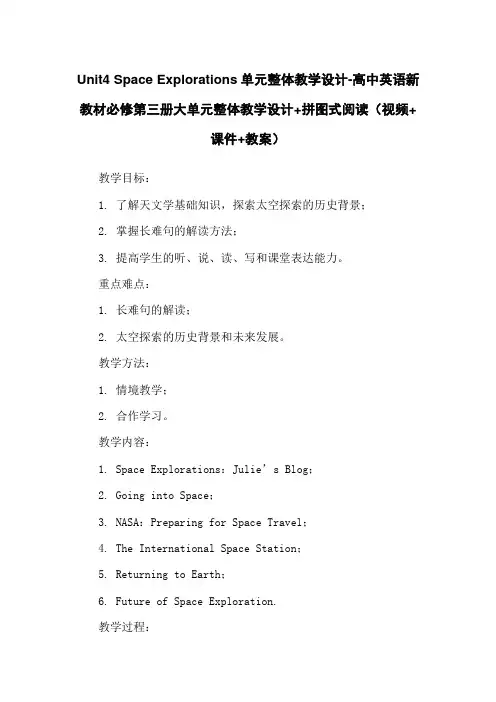
Unit4 Space Explorations单元整体教学设计-高中英语新教材必修第三册大单元整体教学设计+拼图式阅读(视频+课件+教案)教学目标:1. 了解天文学基础知识,探索太空探索的历史背景;2. 掌握长难句的解读方法;3. 提高学生的听、说、读、写和课堂表达能力。
重点难点:1. 长难句的解读;2. 太空探索的历史背景和未来发展。
教学方法:1. 情境教学;2. 合作学习。
教学内容:1. Space Explorations:Julie’s Blog;2. Going into Space;3. NASA:Preparing for Space Travel;4. The International Space Station;5. Returning to Earth;6. Future of Space Exploration.教学过程:Step 1 自主学习让学生先自主阅读Unit 4 Space Explorations中的Julie’s Blog这一部分,了解一些基础知识。
Step 2 合作学习1. 让学生以小组合作形式讨论、搜集有关太空探索的基础知识,并将自己的发现与小组成员分享。
2. 让学生在小组内完成课本中Going into Space和NASA:Preparing for Space Travel两个环节的小组复述任务,多次演练,锻炼表达和听取的能力。
Step 3 教师讲授1. 教师讲解The International Space Station 和Returning to Earth两个环节的知识,注重引导学生解读长句。
2. 教师借助多媒体工具讲解与Future of Space Exploration有关的知识。
Step 4 拼图阅读1. 让学生自觉分组,每个小组负责一个主题,分别为:(1) Space Explorations: Julie’s Blog;(2) Going into Space;(3) NASA: Preparing for Space Travel;(4) The International Space Station;(5) Returning to Earth;(6) Future of Space Exploration。
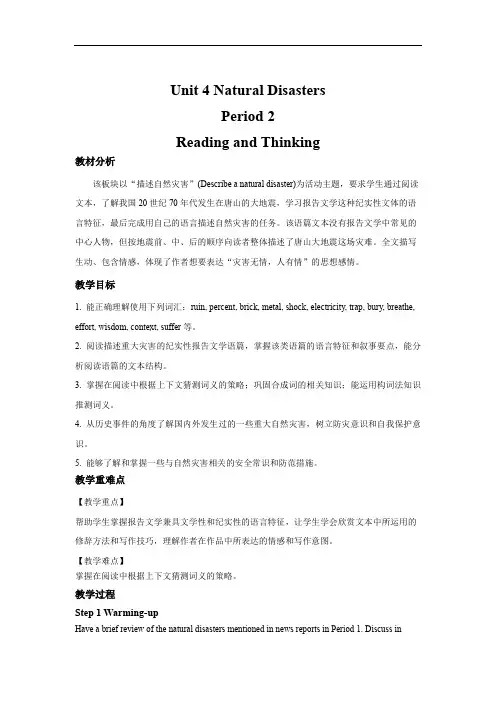
Unit 4 Natural DisastersPeriod 2Reading and Thinking教材分析该板块以“描述自然灾害”(Describe a natural disaster)为活动主题,要求学生通过阅读文本,了解我国20世纪70年代发生在唐山的大地震,学习报告文学这种纪实性文体的语言特征,最后完成用自己的语言描述自然灾害的任务。
该语篇文本没有报告文学中常见的中心人物,但按地震前、中、后的顺序向读者整体描述了唐山大地震这场灾难。
全文描写生动、包含情感,体现了作者想要表达“灾害无情,人有情”的思想感情。
教学目标1. 能正确理解使用下列词汇:ruin, percent, brick, metal, shock, electricity, trap, bury, breathe, effort, wisdom, context, suffer等。
2. 阅读描述重大灾害的纪实性报告文学语篇,掌握该类语篇的语言特征和叙事要点,能分析阅读语篇的文本结构。
3. 掌握在阅读中根据上下文猜测词义的策略;巩固合成词的相关知识;能运用构词法知识推测词义。
4. 从历史事件的角度了解国内外发生过的一些重大自然灾害,树立防灾意识和自我保护意识。
5. 能够了解和掌握一些与自然灾害相关的安全常识和防范措施。
教学重难点【教学重点】帮助学生掌握报告文学兼具文学性和纪实性的语言特征,让学生学会欣赏文本中所运用的修辞方法和写作技巧,理解作者在作品中所表达的情感和写作意图。
【教学难点】掌握在阅读中根据上下文猜测词义的策略。
教学过程Step 1 Warming-upHave a brief review of the natural disasters mentioned in news reports in Period 1. Discuss ingroups what can happen to a city during a big earthquake.设计意图:回顾上节课的内容,激活关于自然灾害和地震的背景知识。
课时教学设计1(参考)课时教学设计2(参考)3.Do you know why an earthquake happens? Why do some countries have a lot of earthquakes?Step2. Prereading Talk about the title “A Night the Earth Didn’t Sleep”Step3.Fast reading1. What does the passage mainly talk about?The passage mainly talks about a terrible________(回答what?) that happened in ________( where?) in _______( when? ) and caused great damage to people.2. Structure of the passagePart 1 (Para.1 ) before the earthquake Part 2 ( (Para.2 &3 ) during the earthquake Part 3 ((Para.4 ) after the earthquake Step4.Detailed reading1.Mindmap the first part2.Fill in the blanks.1) of the nation felt the earthquake. desire of thinking and speaking about the topic.*to know the main idea and structure of the passage.*find and proc ess informatio n to develop st udents’ thinkin g .how to help people who suffered a lot after earthquake.Three topics related to the passage for students to di scuss and share. Step 7. HomeworkWrite a letter to tell people how to protect yourself i n the earthquake.板书设计(含思维导图)作业设计(1) 晚练(四篇阅读理解+七选五) (2) 同步《课时小练》 (3) 《双语报》练习 教学反思附:课时教学设计3(参考) 课题 Unit 4 Natural DisastersDiscovering Useful StructuresPart 1 (Para.1 ) before the earthquakePart 2 ( (Para.2 & 3 ) during the earthquake Part 3 ((Para.4 ) after the earthquake。
Unit 4整体单元设计及嵌入型评价一、单元主题Natural disasters二、课标分析(1)新课标要求理解上下文语境。
在本单元的阅读中,学生需要通过理解语篇中的上下文语境,从而猜测出生词的意思;(2)新课标要求在语境和情景中,记忆并且运用词汇。
本单元的主题是自然灾害,学生通过接触话题内容记忆词汇,进而能够使用这些相关词汇简要介绍和报道突发的自然灾害以及撰写重大自然灾害时间的专题报道;(3)新课标要求学生了解自然灾害所带来的危害以及面对灾害时采取措施,培养面带灾害时的基本素质和积极应对的精神。
同时,新课标要求学生树立面对灾害时守望相助、乐观的精神。
三、单元分析本单元围绕着“人与自然”这一主题,主要是以自然灾害这一话题展开讨论,探讨了自然灾害的种类、近现代历史上国内外发生过的重大自然灾害时间、灾害所带来的威胁和损失以及人们面对灾害是能够采取的措施等方面的内容。
本单元旨在帮助学生了解自然灾害、积极应对与防范并且采取有效措施,这是应具备的素质与能力。
本单元还力图宣扬在重大自然灾害面前勇敢无畏、守望相助、重树信心,重建家园的主题意义。
本单元大情境呈现的是一群解放军战士在汶川地震的废墟中运送伤者的感人情景,意在潜移默化地给学生传递重大自然灾害时的合力救助的人道主义精神和无私奉献精神。
四、单元学情学生优势:学生身处沿海地区,对台风这类自然灾害比较熟悉,同时了解一些国内重大自然灾害,比如唐山大地震与汶川大地震等。
对单元话题相对熟悉,并不陌生,在初中的学习时对此话题也有所接触。
学生劣势:(1)学生只是大致了解自然灾害的种类,对自然灾害的应对措施不够了解(2)学生对定语从句的掌握不够(3)学生不能对重大自然灾害进行新闻报道和新闻撰写。
五、学习目标(1)通过积累自然灾害相关的话题词汇,识别并掌握tornado,drought,slide,tsunami等单词词意;(2)通过复习清辅音和浊辅音的发音规律,并利用规律准确辨音,有效记忆单词;(3)通过复习that、which、who(whom)引导的定语从句,学习并掌握用whose引导的定语从句,能够用关系代词引导的定语从句描述事物的具体信息;(4)通过听力问题,预测听力内容并且提炼出关键信息,如数字、时间、日期、事由等;(5)通过把握文章语境,结合上下文猜测词义;(6)通过阅读描述重大灾害的文章,模仿新闻简报,报道突发的自然灾害;(7)通过阅读关于海啸的范文,能够为重大新闻事件的专题报道编写摘要。
教学设计一、教学目标:(一)知识与技能:1. To help students get some information about Tangshan earthquake.2. To improve students reading strategies.(二)过程与方法:1. To help students to know how to face some disasters or troubles2. To help students to know the way to find out information.(三)情感态度与价值观:1. To develop students respect our leaders, our army and other person ;2. To cherish life.3.To develop students awareness of cooperation.二、重难点:1. Help students find out important information.2.Improve students’ reading an d presentation skills.三、教学方法:Task-based methods四、教学用具:Multi-media computer五、教学过程:Step 1 : Lead-in1.Show some pictures of disasters2.Take Wenchuan earthqwake for example and have a free talkWho will help us when we are in trouble,or we are trapped in the disasters?Step 2: Pre-reading1.Practise the new words and phrases in the reading part .2.What do you think may happen before an earthquake?3.A short movie of Tangshan earthquakeStep3:While-reading1.Fast-readingFind the answers and the main idea.Read the text quickly and find out the topic sentence of each paragraphSum up the main idea of each part of the passage. (choose one word to describe)2.Careful readingPara. 1: Before the earthquakePara. 2-3 During the earthquakePara. 4: After the earthquakeStep4:After-readingFill in the blanks and retell the story.____________ happened in Tangshan. For three days, water in the wells _____________. From the cracks of wells __________ came out. Mice, chicken, pigs and even fish became________.At 3:42 am, everything began to ______. It seemed as if the world was _________. _________ of the nation felt it. In fifteen terrible seconds a large city lay _______. More than ________people were killed and seriously ________.But all hope was not lost. Soldiers and the ____________ came to help . Slowly, the city began to ________again.Step5:SummeryWhat can we learn from the this earthquake?How terrible the earthquake is!However, we are lucky and live a happy life,so we should work harder and cherish(珍惜) our lives! ……Step 6:HomeworkWrite a short passage about Tangshan earthquake according to what we have learnt.学情分析本班学生为普通班学生,学生基础相对比较薄弱,平时测试只有十几个及格。
高中英语人教2019版必修一Unit4 Natural disasters单元教学规划措施,这些也是21 世纪公民应该具备的基本素质。
“用生命呼吁:增强减灾意识,减少人员伤亡。
”是本单元的活动主题,目的是呼吁全球各地的人们重视自然灾害,树立防灾意识。
深入学习自然灾害相关表达,提升语言能力;梳理整合语篇要素与特征,提升学习能力;传播防灾知识,培养文化意识;批判性地表达自己观点,多途径收集资料,培养思维品质。
【How】本单元从认识自然灾害的种类开始,到介绍近现代历史上国内外发生过的重大自然灾害事件,再到探讨面对灾害的威胁和所造成的损失时,人们可以采取的应对措施。
本单元的阅读文本通过详细地对唐山大地震发生前各种奇怪现象的介绍,说明地震发生前的很多预兆没有引起当时人们的注意和警觉,帮助学生了解一些地震前兆的知识。
文章对地震发生中和发生后的介绍,不仅帮助学生更加生动具体的了解了这段惨痛的历史,也让学生在阅读最后两段关于救援工作和地震重建工作介绍的同时为唐山人民的团结与智慧,拼搏与奋斗精神所震撼和鼓舞。
本单元通过主题阅读Reading1(p50) 纪实性报告文学,描述地震和对Reading2(p54)新闻报道--海啸文本的详细分析和学习,来体现核心素养价值,让学生重视自然灾害,树立防灾意识,体会“灾害无情,人间有爱”的大爱精神。
围绕着单元主题意义进行深度的探究重点:是让学生通过PBL项目式学习探究并拓展关于自然灾害的相关主题知识,影响以及防御的知识,提升我们人类对自然灾害的敬畏,同时做好自然防范灾害,积极防范方面的意识和能力。
引导学生有意识的去发现哪些自然灾害是通过人为活动是可以防防止的,这种环境保护,比如说山体滑坡,比如说沙尘暴这些是或者是可以减缓的,哪些是不能防止的?我们只能是采取相关措施进行自我保护等相关的知识。
体现Prevent,promote and protect预防、促进和保护三方面。
2、学情分析学情分析:通过相关的学情调查,以reading and thinking 为例,让学生说一下,在地震中要采取什么防范的措施?地震前有什么征兆?主要的原因形成的原因,防御的方法以及基于此我们能做什么?还知道哪些自然灾害?由此引导学生进行PBL 调查研究学习。
人教新版选择性必修一Unit 4 Body Language第三课时Explore body language(P4243)一、内容分析本板块的主题是体态语言在人际交流中的作用。
这一主题涉及的音韵知识包括感知和运用不同的语音节奏和语调,以便更好地理解和表达信息。
语用知识主要关注在不同文化和社会背景下适当和有效地使用体态语言。
材料中融入了丰富的文化知识,如不同国家和地区体态语言的差异和用法。
该教学材料主要涉及听力和口语技能。
学生需要通过听力活动理解对话内容,然后参与讨论和角色扮演,实践他们的口语技能。
学习策略方面,材料鼓励学生通过观察、比较和实践,深化对体态语言的理解和运用。
学习活动设计有助于学生掌握和运用体态语言。
通过观看照片和讨论,学生能够观察和解读不同情境下的体态语言;通过听对话和回答问题,他们能够听到体态语言在实际对话中的运用,并思考其意义和作用。
角色扮演活动则让学生亲自实践体态语言的运用,提升他们的实践技能。
学生通过学习这个听说课的材料,不仅可以提升他们的语言技能,更能增强他们的文化意识和交际能力。
他们将学会在不同文化和社会情境下,如何适当和有效地运用体态语言进行沟通,这对他们未来在多元文化环境中生存和发展具有重要意义。
二、教学目标1.To introduce and discuss the concept of nonverbal munication, specifically body language.2.To enhance students' listening and prehension skills.3.To practice speaking and using body language to convey messages effectively.三、教学重难点教学重点Understanding the significance of body language in munication and practicing nonverbal munication skills.教学难点Interpreting body language accurately and effectively using body language to municate.Materials:1.Textbook material with pictures and conversation transcript.2.Pictures related to body language (provided in the material).3.Whiteboard and markers.4.Handouts with conversation questions.5.Audio recording of the conversation.Introduction (2 minutes):1.Begin by discussing the importance of nonverbal munication and how body language plays a significant role ineveryday interactions.2.Present the lesson objectives and explain that students will be exploring various aspects of body language andnonverbal munication.Activity 1: Analyzing Pictures (5 minutes):1.Show students the pictures provided in the material (Picture 1 to Picture 4) and ask them to discuss in pairs or smallgroups what they think each person is municating through their body language.2.Encourage students to use descriptive language and speculate on the emotions and messages conveyed in eachpicture.3.Have each group share their observations and interpretations with the class.Activity 2: Listening prehension (10 minutes):1.Play the audio recording of the conversation provided in the material.2.Distribute the transcript of the conversation with gaps for missing words and phrases.3.In pairs, students should listen to the conversation and fill in the missing words and phrases to plete the transcript.4.Discuss the conversation as a class, emphasizing the role of body language in munication.Activity 3: Discussion (10 minutes):1.Provide students with handouts containing discussion questions related to the conversation they listened to.2.In small groups, students should discuss and answer the questions based on the conversation's content.3.Facilitate a class discussion, allowing each group to share their insights and answers.Activity 4: NonVerbal munication Performance (10 minutes):1.Divide students into groups of four. One student in each group will be the performer, and the others will beobservers.2.The performer should write down a situation and messages they want to convey using only body language.3.The performer acts out the scene without speaking, while the observers individually write down theirinterpretations and observations.4.After the performance, the actor reveals the situation and messages, and the group pares notes. Use the providedtable for clarification if needed.Summary (3 minutes):1.Summarize the key points of the lesson, emphasizing the significance of body language in munication. Homework Design:Assign students the following homework:•Write a short paragraph describing a situation where they successfully used body language to municate, or a situation where they struggled to understand someone else's body language.Advice on Teaching:•Encourage students to be observant of body language in their daily interactions.•Emphasize the importance of cultural sensitivity when interpreting body language, as gestures may vary across cultures.•Use reallife examples and personal anecdotes to illustrate the effectiveness of nonverbal munication.。
新修订高中阶段原创精品配套教材高中英语新教材UNIT4教学设计教材定制 / 提高课堂效率 /内容可修改Teaching Design of UNIT4, a New High School English Textbook教师:风老师风顺第二中学编订:FoonShion教育高中英语新教材UNIT4教学设计高一新教材Unit 4说课教案,教学设计高一新教材Unit 4说课教案,教学设计一.教学目标理论依据:《新课程标准》(实验稿)根据《新课程标准》(实验稿)关于总目标的定位及其实现途径和目标具体描述,结合高一学生实际和教材内容,我们把本单元的教学目标定为:1)语言知识:单词:理解、内化、运用以下生词:seismograph; iceberg; King Tut; // roar; fright; crack; // bookworm; couch potato; workaholic;// Buddha; agent等,扫除听读障碍,重点掌握一些传神动词:advance; seize; sweep; swallow; drag; pull; flow; shake; strike; struggle等。
词组:get on one’s feet; tree after tree语法:复习和运用定语从句用于描述人、物及事件。
2)语言技能:听:听懂一个关于不幸经历的小故事,抓住时间、地点、人物、发生的事件说:能用得体语言描述人、物、事件,并且有一定的逻辑。
读:Scanning, skimming, careful reading, generalization; inference等阅读微技能训练。
写:能运用First, Next, Then, Finally简要且富有逻辑地描写自己的一次难忘经历。
3)学习策略:学生一定程度形成自主学习,有效交际、信息处理、英语思维能力。
4)情感态度:学生能在多种英语学习情景中分享自己的幸与不幸,体验用英语交流的成功与喜悦,以及培养合作精神、互助精神。
二.教学重点和难点:重点:1. 课文中出现的重要动词,如:advance, seize, sweep, swallow, strike, struggle, drag, flow, shake, 及词组get on one’s feet, pull oneself, tree after tree etc.2. 用关系代词who, that, whom, whose等引导的定语从句.3. 用副词first, next, then, finally 来描述一场难忘的经历.难点: 能用得体的英语表达自己,描述过去的难忘经历。
三. 教学方法根据我们几年来二语习得论、“整体语言教学”的理论和实践,以及当前教学改革,课程改革等先进理念,为达成上述教学目标,运用任务型教学途径,我们英语课堂设计采取“P---T---P”自主学习立体模式:(Pre-task----Task-cycle----Post-task)。
四. 教学安排根据学生学习英语的特点和规律,学习阶段的侧重点以及高一学生的发展,我们把本单元划分为6课时:听力、口语、阅读(2课时)、语言(0.5课时)、写作、评价(0.5课时)。
下面请看我们的课堂教学设计。
Period I warming up and listeningⅠ、教材内容及教学目标本课处于本单元的第一课时,主要训练和提高学生‘听’的技能,它的掌握有利于以下几课的‘说’、‘读’和‘写’的技能训练,并作了一个很好的铺垫.本课的听力材料由两部分组成,主要讲述Hank Stram在地震前所做、地震中所见、所闻和所感的令人难忘的经历。
通过完成练习,学生能抓住所听语段中的关键词、理解话语之间的逻辑关系、听懂故事、理解其中主要人物和事件以及他们之间的关系等。
而且学生能掌握较好的听力方法,如积极预测、注意抓关键词、善于跳跃难点、学会做笔记等等。
通过本课学习学生能复习定语从句以及学会正确使用指人或物的关系代词.Ⅰ、教学设计A. Warming up :Task 1 Matching competition (group work)Column A Column B1、Fu Jian Province a、a cartoon maker2、San Francisco b、the electric lamp3、Alexander Bell c、the first telephone4、Thomas Edison d、earthquake5、Albert Einstein e、typhoon6、Walt Disney f、the Theory of RelativityQuestion: Why do you think so ?Task2: Looking at the following pictures, find out the answers to the questions:1) Do you know who or what they are ?2) What made them unforgettable?3) Can you describe each picture using one sentence( with the help of the words under the picture)Task 3: Let the students describe each picture with Attributive Clause.eg: Zhang Heng is the man who made the earliest seismograph in 132.B. Pre-listeningTask1: Before listening , let the Ss guess the possible answers to the following questions according to the situation: (group work)1) When did the earthquake happen?2) Where was the man driving when it happen?3) What was he going to do?Listening(Part 1):Task 2: Listening to the tape to get the correct answers to the above questions.(for the first time)Task 3: Listening to the tape to put the following into the right order.( ) 1. I stopped the car and at the same time the road fell onto the cars in front of me.( ) 2. I was hungry so I started to eat one.( ) 3. I saw the cars in front of me start to move from side to side.( ) 4. I had finished work and then gone to the Post Office.( ) 5. I slowed down ,then my car started to shake.( ) 6. I stopped off at a shop in order to get some fresh fruit.( ) 7. I drove even slower, then the road above started to fall down.Task 4: Letting the Ss listen to the tape again, then try toretell the story simply, using their own words.Task 5 : Discussion (Group work)What would happen to Hank Stram finally?Listening (Part 2)Task1: Listening to the second part to choose the best choices(for the first time)1. Which part of his body hurt badly?( C )A. The bottom parts of his legsB. The bottom parts of his hands.C. The bottom parts of his legs and feet.2. What could he hear below him?( B )A. NothingB. Shouts and noiseC. The noise of cars3. How long had he been in the car?( A)A.14 hoursB. 40 hoursC.4 hoursTask 2: Listening to the tape again to write the words in the spaces.1. I ____ myself in the dark.2. Then I remembered what____.3. It was clear to me now that I ____ in an earthquake.4. Then I ____ people____ towards me.5. A team of people____ to see if anyone _____ under the broken road.C. Post-listening:Task 3: DiscussionWhat made him survive in such a terrible accident?Period 2 SpeakingⅠ、教材内容及教学目标本课着重培养学生‘说’的技能, 通过复习、学生自我介绍、解说图片、自编对话等手段来巩固定语从句中指人的关系代词who or whose 的用法,达到能有条理地描述个人体验和表达个人的见解和想象、能传递信息并就熟悉的话题表达看法、能用英语进行语言实践活动。
它的掌握是一个很好的过渡阶段―――进入‘读’和‘写’的技能训练.Ⅰ、教学设计Pre-task: 活跃学生用英语交流的思维, 通过复习引出本课的重点---定语从句中指人的关系代词who or whose 的用法。